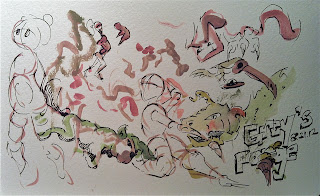The animation was just to gauge where we were; a walk cycle where anything goes. I wanted mine to loop and keep it simple yet throw in a tiny bit of perspective, so I went with a cube with legs, which morphed into a Wally'esque type robot. Haha, I love him, he's really cute. ^_^
Animation is below:
Was a busy weekend filled with trees and building my own little animation downshooter. Still had the program Flipbook from Art28 but I was really unhappy with how the macbook's little webcam handled capturing each page so I ordered a new HD webcam from Amazon and fashioned a mount for it with some scrap wood, screws/brackets and some plexiglass which I could attach the suction cup arm to. Came out looking kinda snazzy. ^_^
Page from my tree sketchbook (Owen said it was alright for the first pass. I need more detail!):
Tuesday we brought our pine cones (Special thanks to Missy for finding these awesome ones for me). Mine are apparently from an Austrian Black Pine and are smallish (2-3"), light exterior, black interior, with a small prickle. We dismantled one of the two and started a graphite drawing of the second. Tonight I found out 20 factoids of pine cones which was actually kinda interesting. I never realized that there were a male and female pine cone (the ones we're familiar with are the mature females).
They say knowledge is power but one has to ask how learning about pine cones beyond what you simply see can help you draw? Honestly, anything more you know about an object will help you draw it better and more accurately. Owen used the word "authentic". You want to make your drawings believable. For example, learning anatomy will just make your figure drawings that much better, that much more believable. And once you know how things work, you can start bending, even breaking the rules because you know how you can push it.
Oh and pines cones (specifically from the family Pinaceae); their scales grow in the fibonacci number sequence, or the golden ratio. It's one of the biological examples of this perfect design. Other examples found in nature are artichokes (go figure, they look like pine cones), ferns, and the shell of a nautilus.
Pictures of my awesome pine cone, both dismantled and lit up for a still life:





























